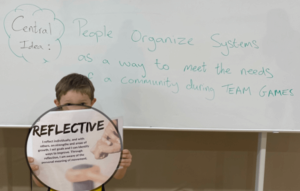After a seven-year hiatus from teaching within the International Baccalaureate (IB) framework, returning to the Primary Years Programme (PYP) Physical and health Education (PHE) curriculum was a daunting task. The IB had evolved in my absence, and I felt a mixture of apprehension and excitement as I embarked on this educational journey once again. However, now that I have settled back into the PYP PE realm, I can confidently say that the confusion was outweighed by the rewards. In this blog, I will share my experiences, the strategies I adopted to ease the transition, and the gratifying results I witnessed as a result of incorporating student inquiry and agency.
1) Embracing the Learner Profiles:
One of the first steps I took to reintegrate into the PYP PE realm was incorporating learner profiles into my daily interactions with students. I actively used these profiles while complimenting or redirecting their behaviour, emphasising the qualities that aligned with the learner profiles and the PYP values. For instance, when a student approached a teammate with empathy and offered support, I would say, “Your act of kindness and empathy exemplify the caring attribute of the learner profile. Well done!” Or “”Today, we will learn about being principled in PE class. It means playing fair and following the rules. Cheating isn’t okay because it takes away the fun. Let’s all promise to be honest and fair. If you see someone cheating, remind them about the rules. Together, we can make our games fun and fair!”
2) Directing through Questions, Not Commands:
Another strategy I adopted was constantly asking myself if I could reframe my instructions as questions rather than directions. By doing so, I encouraged students to reflect, reason, and take ownership of their learning experiences. For example, instead of saying, “Run faster,” I would inquire, “How can we create more speed during this sprint? What strategies might work?” students could then apply this knowledge to game situations.
3) Foster Self-Reflection through Learner Profile Analysis:
To deepen students’ understanding of the learner profiles, I introduced reflective activities, such as asking them to consider which specific profiles they used most during a lesson or unit. This reflection could be as simple as taking a picture of a student engaged in a particular action and then asking the students to annotate the picture with the corresponding learner profile and a description of how it was utilised.

Next Steps: Creating PYP PHE Unit Plans for Grades 1-5. Check out my latest resource, a Grade 4/5 Target Games scheme of learning which I have made IB friendly with the theme of Where We are in Place and Time. Focused learner profiles and ATLs are identified, and a particular focus of migrations is explored. Check it out on my resource page at www.onceuponapelesson.com
Exploring Visible Thinking Skills in PYP PE: As I continue to immerse myself in the PYP PE curriculum, I have also become an active member of a Professional Learning Community (PLC) focused on visible thinking skills. In an upcoming blog, I will delve into how these techniques have been integrated into my PYP PE teaching practice. Stay tuned to discover the positive impact these strategies have had on student engagement, critical thinking, and overall learning outcomes.
Returning to the PYP PE landscape after a prolonged absence from the IB system was undoubtedly challenging. However, my reintegration journey has been a truly rewarding experience. By incorporating learner profiles, reframing instructions as questions, and promoting self-reflection, I witnessed the powerful impact of student agency and inquiry in their physical education learning. As I progress, I am excited to explore visible thinking skills further, nurturing a classroom environment where students thrive intellectually, physically, and socially.




